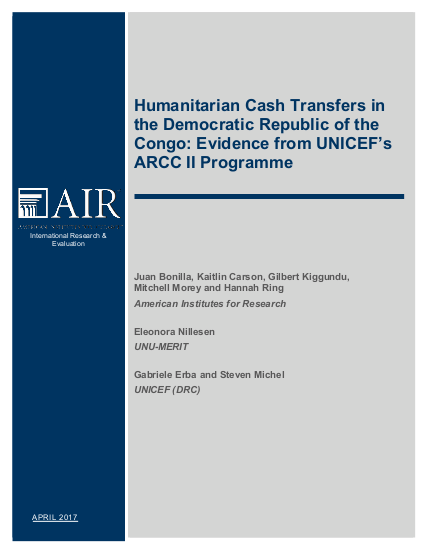
From March 2013 to September 2015, UNICEF and three partner organizations (Concern Worldwide, Mercy Corps, and Solidarités International), collaborated to deliver what was at the time the single-largest unconditional cash transfer programme for humanitarian response in the Democratic Republic of the Congo (DRC).
Funded primarily by UKaid from the United Kingdom government, UNICEF’s Alternative Responses for Communities in Crisis (ARCC II) programme reached 23,480 displaced families, host families, and returning displaced families in eastern DRC. Based on an analysis of extensive quantitative and qualitative data collected by the ARCC partners, as well as additional qualitative data collection in the field, AIR and UNICEF used evaluation methods to investigate the effects of the ARCC II programme.
The theory behind the ARCC approach is that conflict-affected families in the DRC confront a wide variety of needs depending on the specific events they have experienced, the geography of their place of refuge or return area, the use of adaptive coping mechanisms, and individual family circumstances. ARCC also believes that markets in eastern DRC have adapted to the ongoing crisis and are dynamic and responsive in providing communities access to basic needs. As such, flexible cash-based response can be an effective alternative to in-kind based humanitarian relief programming.
The ARCC approach is based on the hypothesis that families who receive unconditional voucher and cash assistance will make purchases that will increase access to basic goods, services, and livelihood opportunities, ultimately enhancing their well-being and resilience.
We find evidence to support this hypothesis. Using detailed analysis of participant families purchasing patterns, this paper shows that cash was used by recipients in line with ARCC II objectives. Furthermore, drawing from quasi-experimental methods, we show that ARCC has contributed significantly across the board to improvements in well-being, reductions in vulnerabilities and use of negative coping mechanisms, and ultimately to increased resiliency at the household level.